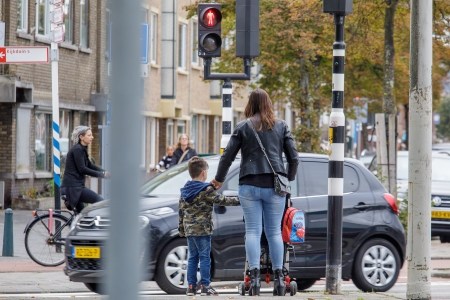Below you will find the list of references that are used in this fact sheet. Our knowledge portal offers more literature on this subject.
[1]. Senserrick, T., Ivers, R., Boufous, S., Chen, H.-Y., et al. (2009). Young driver education programs that build resilience have potential to reduce road crashes. In: Pediatrics, vol. 124, nr. 5, p. 1287-1292.
[2]. Nägele, R. & Doff, H. (2009). Implementatie van verkeers- en gezondheidseducatie in het voortgezet onderwijs: een literatuuronderzoek. Kennisplatform Verkeer en Vervoer (KpVV), Rotterdam.
[3]. Vermeulen, W. (2009). Overzicht verkeerseducatie in Nederland: stand van zaken en vooruitzicht. Ministerie van Verkeer en Waterstaat, Directoraat-Generaal Rijkswaterstaat, Dienst Verkeer en Scheepvaart DVS, Delft.
[4]. CROW (2016). Toolkit Verkeerseducatie. CROW. Geraadpleegd 03-10-2017 op http://www.crow.nl/mobiliteit-en-gedrag/tools/toolkit/documenten/fight-your-inner-monkey?onderwerp=505;&page=1&searchsort=date&pagesize=10&parenturl=/Mobiliteit-en-Gedrag/Tools/Toolkit.
[5]. Claassen, A. (2010). Wat heb je ervan geleerd? Focussen !!!! Procesevaluatie van het pilot-project ‘Power of Control’: Hoofdrapport. ITS, Radboud Universiteit Nijmegen.
[6]. Hoekstra, A.T.G. & Twisk, D.A.M. (2010). De rol van ouders in het informele leerproces van kinderen van 4 tot 12 jaar. Een eerste verkenning. R-2010-19. SWOV, Leidschendam.
[7]. Brooks-Russell, A., Simons-Morton, B. & Ehsani, J. (2014). Parents are the key to improving teen driving safety. In: The Journal of Adolescent Health, vol. 55, nr. 5, p. 600.
[8]. Curry, A.E., Peek-Asa, C., Hamann, C.J. & Mirman, J.H. (2015). Effectiveness of parent-focused interventions to increase teen driver safety: A critical review. In: Journal of Adolescent Health, vol. 57, nr. 1, p. S6-S14.
[9]. Shimshoni, Y., Farah, H., Lotan, T., Grimberg, E., et al. (2015). Effects of parental vigilant care and feedback on novice driver risk. In: Journal of Adolescence, vol. 38, p. 69-80.
[10]. Davidse, R.J. & Hoekstra, A.T.G. (2010). Evaluatie van de BROEM-cursus nieuwe stijl. Een vragenlijststudie onder oudere automobilisten. R-2010-6. SWOV, Leidschendam.
[11]. Korner-Bitensky, N., Kua, A., Zweck, C. Von & Van Benthem, K. (2009). Older driver retraining: An updated systematic review of evidence of effectiveness. In: Journal of Safety Research, vol. 40, nr. 2, p. 105-111.
[12]. Vlakveld, W.P., Twisk, D., Christoph, M., Boele, M., et al. (2015). Speed choice and mental workload of elderly cyclists on e-bikes in simple and complex traffic situations: A field experiment. In: Accident Analysis & Prevention, vol. 74, p. 97-106.
[13]. Poos, H.P.A.M., Lefarth, T.L., Harbers, J.S., Wendt, K.W., et al. (2017). E-bikers raken vaker ernstig gewond na fietsongeval: Resultaten uit de Groningse fietsongevallendatabase. In: Nederlands Tijdschrift voor Geneeskunde, vol. 161, nr. D1520.
[14]. Betuw, A.J.M. van & Vissers, J.A.M.M. (2002). Naar een succesvolle invoering van Permanente Verkeerseducatie: uitgangspunten voor beleid. gezamenlijke Regionale en Provinciale Organen voor de Verkeersveiligheid.
[15]. Vissers, J.A.M.M., Nägele, R.C., Kooistra, A.B., Betuw, A.J.M. van, et al. (2005). Leerdoelendocument Permanente Verkeerseducatie. In opdracht van Directoraat-Generaal Rijkswaterstaat, Adviesdienst Verkeer en Vervoer AVV. Traffic Test, Veenendaal.
[16]. Mesken, J. (2011). De evaluatie van verkeerseducatieprogramma's. Aanbevelingen voor effectmeting en een voorstel voor een verkort meetinstrument. R-2011-8. SWOV, Leidschendam.
[17]. Slinger, W., Koen, F., Vissers, J. & Twisk, D. (2016). Op weg naar effectieve verkeerseducatie: het WEVER-project. Paper gepresenteerd op het Nationaal Verkeersveiligheidscongres NVVC, 21 april 2016, ’s Hertogenbosch.
[18]. Duperrex, O., Bunn, F. & Roberts, I. (2002). Safety education of pedestrians for injury prevention: a systematic review of randomised controlled trials. In: British Medical Journal, vol. 324, nr. 7346, p. 1129-1131.
[19]. Gregersen, N.P. & Nolén, S. (1994). Children's road safety and the strategy of voluntary traffic safety clubs. In: Accident Analysis & Prevention, vol. 26, nr. 4, p. 463-470.
[20]. Twisk, D.A.M., Vlakveld, W.P. & Commandeur, J.J.F. (2006). Wanneer is verkeerseducatie effectief? Systematische evaluatie van educatieprojecten. R-2006-28. SWOV, Leidschendam.
[21]. Twisk, D.A.M., Vlakveld, W.P., Commandeur, J.J.F., Shope, J.T., et al. (2014). Five road safety education programmes for young adolescent pedestrians and cyclists: A multi-programme evaluation in a field setting. In: Accident Analysis & Prevention, vol. 66, p. 55-61.
[22]. Feenstra, H., Ruiter, R.A.C. & Kok, G. (2014). Evaluating traffic informers: Testing the behavioral and social-cognitive effects of an adolescent bicycle safety education program. In: Accident Analysis & Prevention, vol. 73, p. 288-295.
[23]. Vissers, J.A.M.M. (2011). Checklist verkeerseducatie: Kwaliteitsindicatoren voor het beoordelen van verkeerseducatieprogramma's. Advies- en ingenieursbureau DHV, Amersfoort.
[24]. Kok, G., Gottlieb, N.H., Peters, G.-J.Y., Mullen, P.D., et al. (2016). A taxonomy of behaviour change methods: An Intervention Mapping approach. In: Health Psychology Review, vol. 10, nr. 3, p. 297-312.
[25]. Twisk, D.A.M. (2014). Protecting pre-license teens from road risk: Identifying risk-contributing factors and quantifying effects of intervention strategies. Proefschrift Maastricht University, Maastricht.
[26]. Royal Haskoning DHV (2015). Het meten van effecten van verkeerseducatie – Tien gouden regels voor effectmeting. CROW-KpVV, Ede.
[27]. Keith, N. & Frese, M. (2008). Effectiveness of error management training: a meta-analysis. In: The Journal of applied psychology, vol. 93, nr. 1, p. 59.
[28]. Lehtonen, E., Airaksinen, J., Kanerva, K., Rissanen, A., et al. (2017). Game-based situation awareness training for child and adult cyclists. In: Royal Society Open Science, vol. 4, nr. 3. 26

